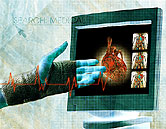New Calcium Measure Better Predictor of Heart Risks
Method gauges distribution of mineral in arteries rather than amount.
|
E-mail this article
Subscribe to news
Printer friendly version
|

(SOURCE: Radiological Society of North America, news release, May 27, 2008)
TUESDAY, May 27 (HealthDay News) -- Improved prediction of a person's heart attack risk can be achieved using calcium coverage scoring, which takes into account not only the amount, but also the distribution, of calcified plaque build-up in the coronary arteries, new research shows.
"Now we know that the location of the calcium in the arteries is particularly important in estimating a patient's potential risk," lead author Elizabeth Brown, a research assistant professor in the department of biostatistics at the University of Washington in Seattle, said in a prepared statement.
A build-up of calcified plaque in the coronary arteries causes cardiovascular disease, the most common form of heart disease in the United States. The current standard of measuring coronary calcium assesses only the amount of calcium, not its distribution.
"Currently, physicians only see the results in terms of an overall score designed to measure the amount of calcified plaque. This new approach will provide physicians with a measure of the proportion of the arteries affected," Brown said.
In the Multi-Ethnic Study of Atherosclerosis (MESA), Brown and colleagues examined CT images of 3,252 people with calcific plaque and 3,416 people without calcific plaque to develop a calcium coverage score for each patient.
All the patients, aged 45 to 84, were then followed for a median of 41 months to determine if there was a relationship between their calcium coverage score and risk of heart attack or other cardiac event.
The researchers found a strong association between calcium coverage score and diabetes, hypertension and dyslipidemia -- abnormal concentrations of lipids (fats) or lipoproteins in the blood.
They also found that calcium coverage score was a better predictor of future cardiac events than just measuring the amount of calcified plaque. A twofold increase in calcium coverage score was associated with a 34 percent increased risk of heart attack or other serious cardiac event and a 52 percent increased risk of any cardiac event.
"Calcium coverage scoring has the potential to improve our estimate of a patient's risk for adverse clinical outcomes, such as heart attacks or death," Brown said.
The study was published in the June issue of Radiology.
More information
The National Heart, Lung, and Blood Institute has more about coronary artery disease.
Copyright © 2008 ScoutNews, LLC. All rights reserved. 
HealthDayNews articles are derived from various sources and do not reflect federal policy. healthfinder.gov does not endorse opinions, products, or services that may appear in news stories. For more information on health topics in the news, visit the healthfinder.gov health library.